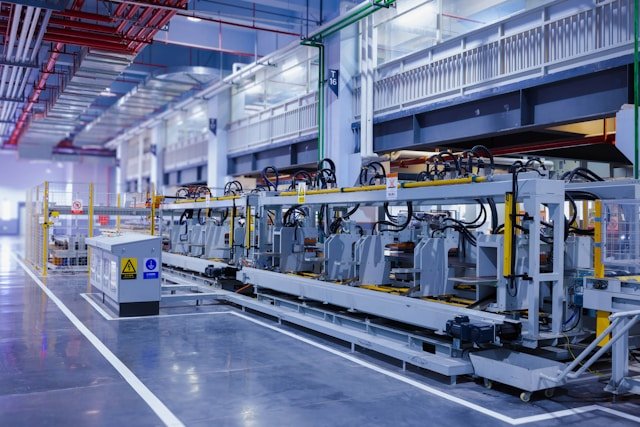In today’s rapidly growing urban landscapes, smart cities are no longer a futuristic concept but an evolving reality. With urban populations swelling, cities face immense pressure to manage resources, improve public services, and enhance the quality of life for their citizens. One of the driving forces behind this urban transformation is automation—a critical component in creating efficient, sustainable, and resilient cities.
Technologies like Electrical switchgear, which help automate and manage energy distribution, are integral to ensuring that smart cities can handle the growing demand for power while maintaining efficiency
Let’s explore how automation is powering the smart city revolution and the ways it’s helping cities run smoother, safer, and smarter.
The Rise of Smart Cities
Cities are the heart of economic growth and human development. By 2050, it is estimated that 68% of the world’s population will live in urban areas. With this population surge comes the challenge of managing resources like energy, water, and waste, as well as addressing transportation, housing, and healthcare needs.
To cope with these complexities, cities are turning to smart technologies—automated systems that integrate Internet of Things (IoT) devices, data analytics, and artificial intelligence (AI).
Smart cities utilize automation to optimize infrastructure and services, making them more efficient and responsive. From traffic management to energy distribution, automation is helping cities reduce waste, cut costs, and improve the overall quality of urban living.
Smart Traffic Management
One of the biggest challenges for cities is managing traffic congestion. Traditional traffic systems are often reactive, relying on outdated methods like fixed traffic lights or manual road monitoring. However, automated traffic management systems are revolutionizing urban mobility.
Automated traffic systems use sensors, cameras, and IoT devices to gather real-time data on traffic flow, road conditions, and pedestrian movement. This data is then processed through AI algorithms that can adjust traffic lights dynamically, redirect vehicles to less congested routes, and even communicate with autonomous vehicles. As a result, cities experience fewer traffic jams, reduced emissions, and shorter commute times.
For example, cities like Singapore and Los Angeles have implemented smart traffic systems that automatically adjust to real-time conditions. This has led to a significant reduction in congestion and greenhouse gas emissions, improving both air quality and the daily experience for commuters.
Energy Efficiency through Automation
Energy consumption in cities is a major concern, with urban areas responsible for over 70% of global energy use. Smart cities are leveraging automation to reduce energy consumption and increase sustainability.
Smart grids, for instance, are automated systems that monitor and manage the distribution of electricity more efficiently. These grids use sensors to detect energy usage patterns and adjust the flow of power accordingly, reducing waste and improving the reliability of energy services.
Additionally, AI Chat interfaces can enhance user interaction with these grids, offering real-time insights and troubleshooting. They also integrate renewable energy sources like solar and wind, balancing supply and demand in real-time.
Smart buildings are another example of automation at work. Equipped with energy management systems, these buildings can adjust lighting, heating, and cooling based on occupancy and external weather conditions. Automated energy systems not only lower electricity bills for residents but also contribute to a city’s overall sustainability goals.
Waste Management: Cleaner Cities, Smarter Systems
Efficient waste management is a key component of urban sustainability. Traditional waste collection methods are often inefficient, with trucks following fixed schedules regardless of actual need. Automated waste management systems, on the other hand, leverage sensors embedded in garbage bins to detect when they are full.
These sensors communicate with a central system that optimizes collection routes based on real-time data, reducing fuel consumption and labor costs. Additionally, automation helps streamline recycling efforts by using AI-powered machines to sort and categorize waste more effectively than manual methods.
Cities like Barcelona and Stockholm have already adopted automated waste management solutions, leading to cleaner streets, reduced operational costs, and a higher recycling rate.
Public Safety and Smart Surveillance
Automation is transforming how cities ensure public safety. Traditional surveillance systems require human monitoring, which can be slow and prone to error. Now, smart cities use AI-driven surveillance systems that automatically analyze video footage, detect unusual patterns or behaviors, and alert authorities in real time.
Automated surveillance also plays a role in disaster management. During floods, fires, or other emergencies, smart systems automatically trigger evacuation protocols, dispatch emergency services, and provide real-time updates to citizens.
For instance, cities prone to flooding use sensors to monitor water levels in rivers and storm drains, sending automated warnings when thresholds are breached. These systems help cities respond to crises faster, potentially saving lives.
Enhancing Public Transportation
Public transportation plays a vital role in any city, but managing it can be complex. Automation simplifies public transport services, making them more reliable and user-friendly.
Cities are now deploying automated trains and buses, which reduce human error and improve punctuality. Automated fare collection systems enhance the passenger experience by enabling seamless, contactless payments, and minimizing delays at stations.
Smart transportation systems analyze passenger data to predict peak usage times and adjust services accordingly. This allows cities to allocate resources more efficiently, ensuring smooth operations, even during rush hours.
Conclusion
Automation is at the heart of the smart city revolution, driving improvements in traffic management, energy efficiency, waste management, public safety, and transportation. A key component in these systems is the Motor Control Center, which ensures seamless operation of electrical equipment and infrastructure, enhancing overall efficiency and reliability.
By harnessing the power of automation, cities can become more resilient, sustainable, and responsive to the needs of their citizens. As urban areas continue to grow, embracing smart technology will be crucial to ensuring a brighter, smarter future for all.


